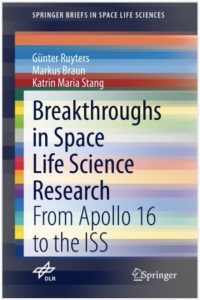Publications

Success Stories: Innovative Developments for Biomedical Diagnostics and Preventative Health Care
Authors: Günter Ruyters 1 , Markus Braun 2, Katrin Maria Stang 2
Affiliations:
- Rheinbreitbach, Germany
- German Space Agency, Research and Exploration German Aerospace Center (DLR), Bonn, Germany
Journal: Breakthroughs in Space Life Science Research - June 2021, Pages 115-138 (DOI: 10.1007/978-3-030-74022-1_4)
-
Field & Applications:
- Space medicine / Gravitational physiology
Research and development programs such as space life sciences often require technical solutions for extreme environments and, in many cases, lead to improvements of existing or to the creation of new production methods or technologies, products, and instruments. Small, compact, light, easy-to-handle, and—if possible—non-invasive application—these are the characteristics of devices and methods, which astronauts prefer for physiological routine measurements and experiments. The same features however are also of great advantage on Earth, especially for newborns and elderly people as well as for routine application in hospitals and in extreme and isolated environments such as Antarctica or in submarines. Therefore, it is not too surprising that technologies and devices originally developed for space are routinely analyzed regarding the potential for terrestrial applications. Also, existing technologies and devices already available on Earth have been improved, tested, and applied in the harsh and challenging conditions of spaceflight thus promoting their commercial success. Overall, these achievements do not only stimulate new markets, industries, and opportunities but also improve the general quality of life. These benefits and the impact on science and economy however are often not immediate and obvious; and not seldom, it takes many years for a new idea to be transformed into a marketable product or service as will be shown in this chapter.
Keywords: Biomedical diagnostics, Commercial devices, Countermeasures, Human physiology, Life cell imaging, Microbiome, Space medicine, Terrestrial application



